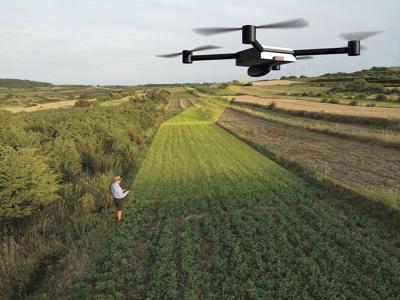In a controversial move, Missouri Department of Conservation has decided to allow hunters to utilize drones to recover deer, turkeys, elk, and bear. The new regulation began with the opening day of the Missouri bow season on September 15
The new rules specify that hunters are still prohibited from using drones to harass, pursue, and take game. There are also a few caveats that drone operators should be aware of regarding permissions, permits, and the possession of weapons. The new regulations stipulate that:
Drone operators need to get permission from a public or private property owner before launching. Using drones on conservation lands requires the explicit permission of a conservation agent.
Drone operators do not need a hunting permit unless they are the person who wounded the animal.
Drones fitted with thermal imagery equipment are permitted when used in accordance with all other regulations.
No one in the hunting party can possess a firearm, bow, or other weapon that can be used to take wildlife while the drone is in flight. The only exception is for concealable firearms.
An in-depth explanation of the new regulations surrounding drones can be found under “Hunting Methods” on p. 4 of the Missouri Wildlife Code.
The MDC’s legalization of drones for deer and other game recovery comes as other Staes struggle with how to regulate the new technology, and as legal challenges to current drone regulations work their way through the courts.
Many people, including hunters themselves, wildlife managers, and lawmakers, have legitimate concerns about fair-chase ethics and whether drones the use of drones will offer hunters an unfair advantage over game. Others worry, too, that their usage could lead to any number of unethical scenarios, such as discovering a bigger buck while trying to locate a wounded deer. MDC is attempting to close this ethical loophole by making it clear that drones cannot be used to harass wildlife, and that a hunter cannot pursue an animal that has been harassed with a drone.
The new drone regulations in Missouri come at a time when there has been a rash of arrests involving massive over limits violations across the state, involving several people in each case. These high visibility cases of grandiose misuses of our natural resources have outdoorsmen wondering how many of such cases go unnoticed and unpunished. It makes one wonder about the validity of using drones to recover game, when the real threat of misusing them to pursue wildlife could easily become a problem going unnoticed as well. It’s common knowledge that conservation agents are spread very thin while covering large geographical areas.
These same concerns have led to nuanced regulations around drones in several states. The National Deer Association provided a look at these rules in its latest Annual Deer Report. The report showed that of the 45 states that responded to NDA’s survey, 17 allowed the use of drones during deer season, and all but four of those allowed drones to be used to recover deer and other game.
A major determining factor involved is whether the recovery process is considered part of the act of hunting. In New York and Pennsylvania, for example, the attempted recovery of a game animal is considered part of the pursuit and taking of that animal. Missouri, however, clarifies that the use of dogs and/or drones to track a wounded deer, elk, bear, or turkey are excluded from its definitions of “pursue” and “take.”
While the new drone technology has become extremely popular in some states, others are banning their use altogether. One entrepreneur finds himself caught in the middle. Mike Yoder, of Ohio, is a small business owner facing big problems for various state regulations. He’s built a successful model around new technology that could change the way hunters recover their deer in the field. However, while the demand for this tech grows, the service he provides has come under heavy scrutiny from state agencies and some members of the hunting community. He’s found himself involved in legal battles spanning multiple states as a larger debate around the tech rages on.
Yoder runs Drone Deer Recovery, an Ohio-based company that specializes in recovering hunter-harvested deer with the use of drones piloted by third party, independent operators. He says that drone deer recovery is a boon for hunters who, without his service, would lose deer they’ve wounded. In the two years since starting his business, Yoder has heard from hundreds of thankful hunters who’ve used the service with success.
On the other side of the fence, some hunters, lawmakers, and wildlife managers argue that recovering deer with drones doesn’t facilitate fair chase principles. Similar to cellular trail cameras and crossbows, the technology has been met with resistance by a certain group who contends that drones offer hunters an unfair advantage and could lead to a number of unethical scenarios.
The drone recovery process is fairly simple. A hunter who is unable to recover a presumably dead deer gets in contact with a pilot listed in Drone Deer Recovery’s directory. The pilot drives out, flies the search area with a thermal-equipped drone, and, more often than not, locates the deer (after confirming it’s the hunter’s target deer using a normal drone camera). The pilot then provides the coordinates to the hunter, who can then go retrieve it.
In January, Yoder received a letter from the New York Department of Environmental Conservation ordering him to cease and desist soliciting operators in New York state. DEC public information officer Lori Severino pointed to the Environmental Conservation Law Section 11-0901 (4)(b)(1) which “prohibits the use of aircraft of any kind to assist in the pursuing, hunting, or taking of game. Pursuant to State law, the use of drones to track and find wounded game is prohibited.”
A lot of state game departments are struggling with how to handle drones. The technology is so new that lawmakers haven’t caught up yet. It’ll be a long struggle. I’ll keep you posted.











